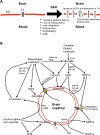Potential therapeutic molecular targets for blood-brain barrier disruption after subarachnoid hemorrhage
- PMID: 30804237
- PMCID: PMC6425837
- DOI: 10.4103/1673-5374.251190
Potential therapeutic molecular targets for blood-brain barrier disruption after subarachnoid hemorrhage
Abstract
Aneurysmal subarachnoid hemorrhage remains serious hemorrhagic stroke with high morbidities and mortalities. Aneurysm rupture causes arterial bleeding-induced mechanical brain tissue injuries and elevated intracranial pressure, followed by global cerebral ischemia. Post-subarachnoid hemorrhage ischemia, tissue injuries as well as extravasated blood components and the breakdown products activate microglia, astrocytes and Toll-like receptor 4, and disrupt blood-brain barrier associated with the induction of many inflammatory and other cascades. Once blood-brain barrier is disrupted, brain tissues are directly exposed to harmful blood contents and immune cells, which aggravate brain injuries furthermore. Blood-brain barrier disruption after subarachnoid hemorrhage may be developed by a variety of mechanisms including endothelial cell apoptosis and disruption of tight junction proteins. Many molecules and pathways have been reported to disrupt the blood-brain barrier after subarachnoid hemorrhage, but the exact mechanisms remain unclear. Multiple independent and/or interconnected signaling pathways may be involved in blood-brain barrier disruption after subarachnoid hemorrhage. This review provides recent understandings of the mechanisms and the potential therapeutic targets of blood-brain barrier disruption after subarachnoid hemorrhage.
Keywords: TLR4; Toll-like receptor 4; blood-brain barrier; early brain injury; endothelial cell; inflammation; matricellular protein; subarachnoid hemorrhage; tight junction.
Conflict of interest statement
None
Figures

Similar articles
-
Underlying Mechanisms and Potential Therapeutic Molecular Targets in Blood-Brain Barrier Disruption after Subarachnoid Hemorrhage.Curr Neuropharmacol. 2020;18(12):1168-1179. doi: 10.2174/1570159X18666200106154203. Curr Neuropharmacol. 2020. PMID: 31903882 Free PMC article. Review.
-
Toll-Like Receptor 4 and Tenascin-C Signaling in Cerebral Vasospasm and Brain Injuries After Subarachnoid Hemorrhage.Acta Neurochir Suppl. 2020;127:91-96. doi: 10.1007/978-3-030-04615-6_15. Acta Neurochir Suppl. 2020. PMID: 31407069 Review.
-
Toll-like receptor 4 as a possible therapeutic target for delayed brain injuries after aneurysmal subarachnoid hemorrhage.Neural Regen Res. 2017 Feb;12(2):193-196. doi: 10.4103/1673-5374.200795. Neural Regen Res. 2017. PMID: 28400792 Free PMC article. Review.
-
Apigenin protects blood-brain barrier and ameliorates early brain injury by inhibiting TLR4-mediated inflammatory pathway in subarachnoid hemorrhage rats.Int Immunopharmacol. 2015 Sep;28(1):79-87. doi: 10.1016/j.intimp.2015.05.024. Epub 2015 May 28. Int Immunopharmacol. 2015. PMID: 26028151
-
Modified Citrus Pectin Prevents Blood-Brain Barrier Disruption in Mouse Subarachnoid Hemorrhage by Inhibiting Galectin-3.Stroke. 2018 Nov;49(11):2743-2751. doi: 10.1161/STROKEAHA.118.021757. Stroke. 2018. PMID: 30355205
Cited by
-
Target inhibition of caspase-8 alleviates brain damage after subarachnoid hemorrhage.Neural Regen Res. 2020 Jul;15(7):1283-1289. doi: 10.4103/1673-5374.272613. Neural Regen Res. 2020. PMID: 31960814 Free PMC article.
-
Melatonin as a Potential Neuroprotectant: Mechanisms in Subarachnoid Hemorrhage-Induced Early Brain Injury.Front Aging Neurosci. 2022 Apr 29;14:899678. doi: 10.3389/fnagi.2022.899678. eCollection 2022. Front Aging Neurosci. 2022. PMID: 35572137 Free PMC article. Review.
-
The Role of Tenascin-C in Tissue Injury and Repair After Stroke.Front Immunol. 2021 Jan 21;11:607587. doi: 10.3389/fimmu.2020.607587. eCollection 2020. Front Immunol. 2021. PMID: 33552066 Free PMC article. Review.
-
New Mechanisms and Targets of Subarachnoid Hemorrhage: A Focus on Mitochondria.Curr Neuropharmacol. 2022;20(7):1278-1296. doi: 10.2174/1570159X19666211101103646. Curr Neuropharmacol. 2022. PMID: 34720082 Free PMC article. Review.
-
Fluoxetine attenuates apoptosis in early brain injury after subarachnoid hemorrhage through Notch1/ASK1/p38 MAPK signaling pathway.Bioengineered. 2022 Apr;13(4):8396-8411. doi: 10.1080/21655979.2022.2037227. Bioengineered. 2022. PMID: 35383529 Free PMC article.
References
-
- Chen G, Zhang S, Shi J, Ai J, Hang C. Effects of recombinant human erythropoietin (rhEPO) on JAK2/STAT3 pathway and endothelial apoptosis in the rabbit basilar artery after subarachnoid hemorrhage. Cytokine. 2009;45:162–168. - PubMed
-
- Connolly ES, Jr, Rabinstein AA, Carhuapoma JR, Derdeyn CP, Dion J, Higashida RT, Hoh BL, Kirkness CJ, Naidech AM, Ogilvy CS, Patel AB, Thompson BG, Vespa P American Heart Association Stroke Council; Council on Cardiovascular Radiology and Intervention; Council on Cardiovascular Nursing; Council on Cardiovascular Surgery and Anesthesia; Council on Clinical Cardiology. Guidelines for the management of aneurysmal subarachnoid hemorrhage: a guideline for healthcare professionals from the American Heart Association/American Stroke Association. Stroke. 2012;43:1711–1737. - PubMed
LinkOut - more resources
Full Text Sources

